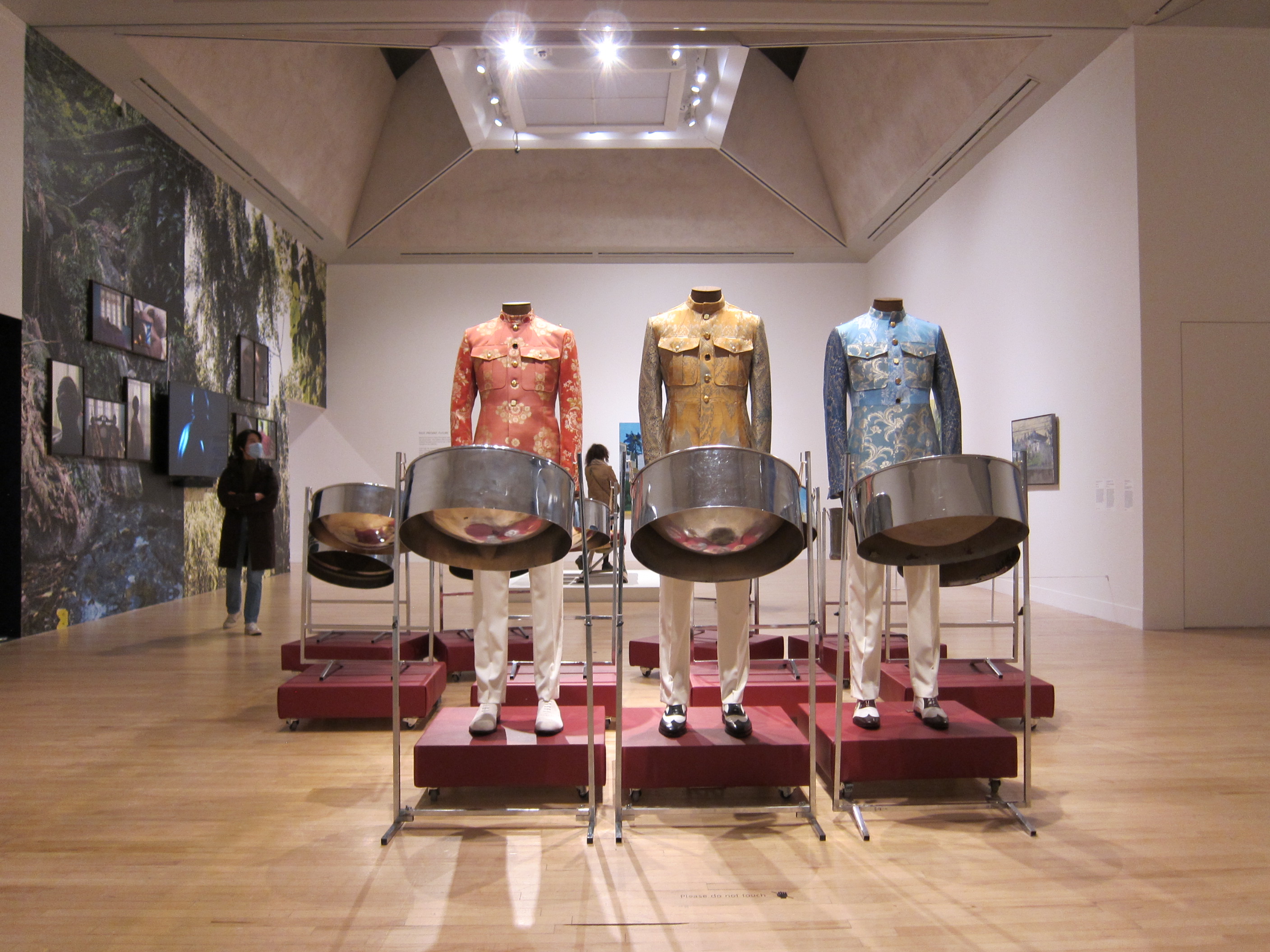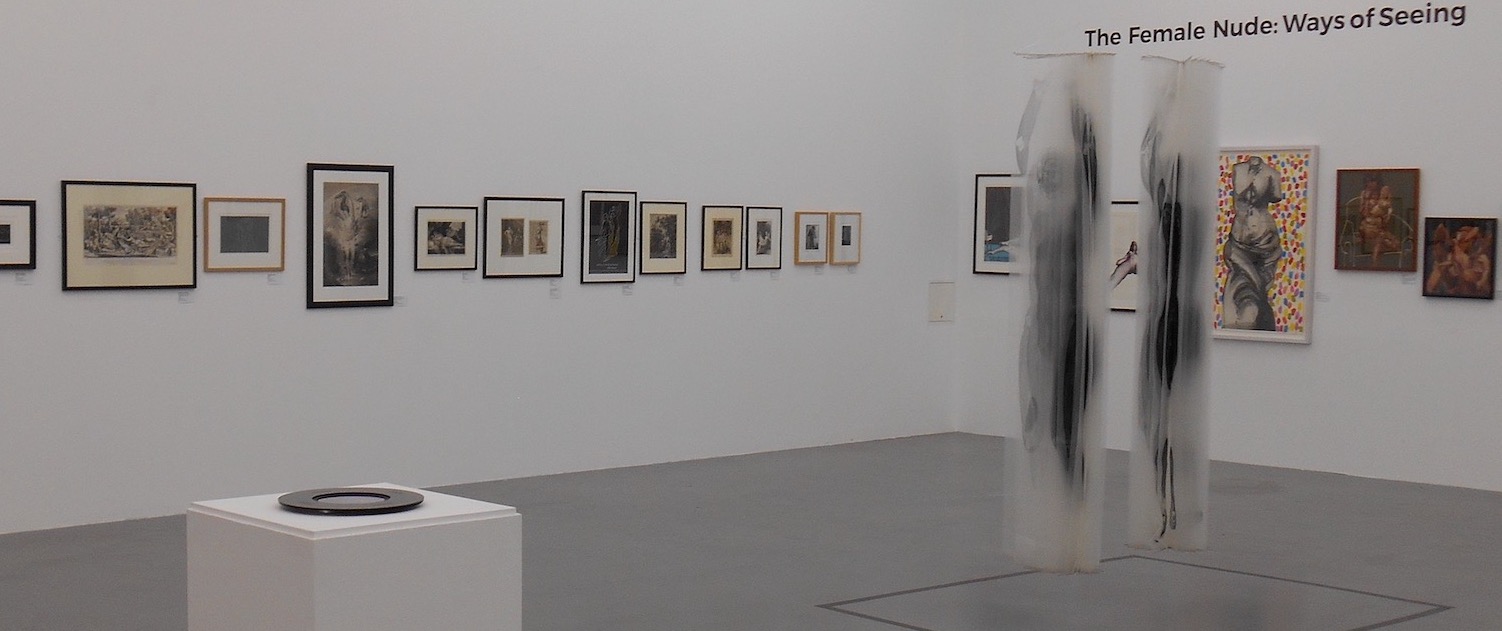A review of musicality in Life Between Islands by third year BA student Clara Dayan

Grace Wales Bonner’s Rhythm Section (2021) in the final room of Life Between Islands
Musicality is one of the main common threads running through the exhibition. Partly chronological, partly thematic, the display brings together multiple overlapping themes, including musicality, rhythm and more broadly, sound system culture. The exhibition can be experienced as a musical journey which embraces the conceptual framework of Barbadian poet and thinker Kamau Brathwaite. Co-founder of the Caribbean Artists Movement, he coined the idea of tidalectics to refer to the sense of movement, flow and time that punctuates the life experiences of the Caribbean diaspora. Brathwaite stresses an alternative perception of the world, different from linear and fixed western models, that fosters a multidisciplinary narrative recalling the past and the present to foresee the future.
References to sound system culture and the musicality of Caribbean and Caribbean-British identity abound throughout the exhibition. At first sight, only a small number of works are related to music by representing or using it as a medium or the subject of their works. However, wandering through the exhibition, one cannot miss all the titles which refer explicitly to music, rhythm and musicians. With this guidance in mind, artworks can be perceived as interpretations of musical experiences. Some of them constitute a tribute to musicians (Aubrey Williams, Shostakovich Symphony no.12 Opus 112, 1981; Steve McQueen references to Bob Marley in Exodus, 1992-97) or to specific Caribbean, African and British traditional rhythmic patterns (Denis Williams, Painting in Six Related Rhythms, 1955; Grace Wales Bonner, Rhythm Sequence, 2021). Others use music as a means to come together, forge and assert a common identity and celebrate their community (Peter Doig, The Music of the Future, 2002-2007; Denzil Forrester, Jah Shaka, 1983). A symphonic and emotional quest for recognition and acceptation. The exhibition traces how Caribbean identity has been built through emigration. The experience of and resistance to systemic hardships and hostility was the fuel of the rising Caribbean identity, which relies on culture to gather both the diaspora and the people who did not emigrate. Life Between Islands celebrates the artists of the Black Arts Movement, created in the UK in the 1980s, who established support networks, explored the politics of representation and intensively denounced the racism experienced by the Caribbean diaspora.
Ingrid Pollard’s Oceans Apart shows how personal narratives both are anchored in and foster broader transcendent histories. Her work expresses a sense of loss, nostalgia and dislocation resulting from migration. In the fragments of letters exchanged with her family members across the Atlantic, time and distance are perceived as cyclical and dynamic. Pollard’s work has a transcending musical dimension, through the association of pictures of noise (the cyclical crashing waves on the coast and family activities) and the rhythm of repeated phrases (“oceans apart”, “wish you were here”). The representation of noise and rhythm is a way of blurring the lines of geography and time, making it a universal experience of loss.
Sound systems were very much part of the means to reconnect with Caribbean culture and claim common and personal identities. Among other genres, the ‘Rebel Generation’, as Dub poet Linton Kwesi Johnson named it, used music not only as a way to celebrate and come together, but also as a shield to face and fight hostility and racism (Neely 2008). Neil Kenlock’s 1974 photograph shows Desmond’s Hip City, the first Black-owned record shop in Brixton which was also a meeting place for Black community, damaged by members of the far-right National Front. The photograph witnesses and documents the normalised violence and systemic racism experienced by the Black community. The display itself stresses the political echoes of Caribbean sound system culture that carry through the show. The emphasis on the hammering of demonstration slogans or the rhythmical carnival processions, often repressed in the 1980s, brandish music as a weapon of identity affirmation.
The text is an extract from Clara Dayan’s review.
Daniel Neely, Reviewed Work(s): Dub: Soundscapes and Shattered Songs in Jamaican Reggae by Michael Veal, 2008 https://www.jstor.org/stable/41699834?seq=1#metadata_info_tab_contents
Ingrid Pollard Oceans Apart 1989, Exhibition Catalogue pp.184-185
